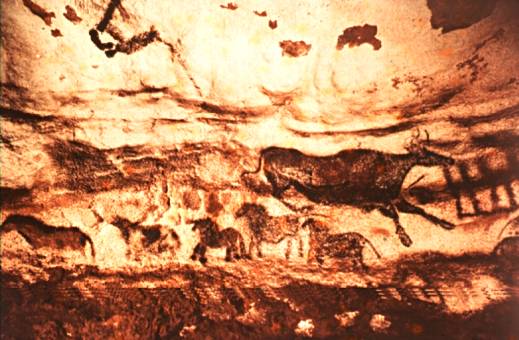An Atlatl, the spear-thower
The tool technologies of the Homo sapiens sapiens has evolved into five categories the first is Chatelperronian and then Aurignacian both dating to 33,000 y.a. Next came Gravettian (27,000 y.a.), then Solutrean (21,000 y.a) and finally Magdalenian (17,000 y.a.). The Aurignacian industry contained retouched blade tools, end scrapers, chisels, fine bone tools and spearheads and the baton de commandement, a bar of antler bone with holes drilled in to them of which the use is unknown. The Gravettian Technology consisted of back blades, with one edge blunted. Solutrean tools are parallel-sided lance heads, flaked on both sides with a fine point. Magdalenian tools are characterized by the Atlatl, the spear-thrower, a wooden or hooked rod use to add force and distance to the spear throw.
An Atlatl, the spear-thower
The barbed harpoon and the bow and arrow were also invented at this time. The punch technique also developed here allowed for standardized blank stones producing numerous burins and chisels.
Due to the changing climate at the end of the last ice age Homo sapiens sapiens were able to construct better more permanent structures. Gravesites in Moscow and other areas give the first evidence of clothing at 22,000 y.a. Here stone awls and bone needles were found along side clothing residue. The clothing has been interpreted as being a hat, shirt, jacket, pants and moccasins. Their diet consisted of fish, reindeer, bison, wild horse, mammoth, fruits, berries, vegetation, nuts and eggs.

Cave painting from Lascaux France
What is the most extraordinary is the appearance of art from 35,000 y.a. to 10,000 y.a. Cave paintings and sculpture was developed by the Homo sapiens sapiens. The best examples of cave art are those from France and Spain. The Lascaux caves in France and the Altamira caves of Spain are covered with the images of wild animals, handprints and stylized linear and dot patterns, made from a variety of organic and inorganic paint-like substances.
Venus of Willendorf (below)
This is the last stage in the evolution of the genus Homo and it is this is the species of Homo that survives natural selection. In only a few thousands of years Homo sapiens sapiens will evolve in to the technological beings we are today.
 There is also the development of sculpture. These sculptures are of a variety of subject mater, but fertility is the constant theme in the works. The most common type of fertility sculpture is of a female shape either realistic or with exaggerated sexual characteristics. This type of sculpture is best represented by, the Venus of Willendorf found in Austria.
There is also the development of sculpture. These sculptures are of a variety of subject mater, but fertility is the constant theme in the works. The most common type of fertility sculpture is of a female shape either realistic or with exaggerated sexual characteristics. This type of sculpture is best represented by, the Venus of Willendorf found in Austria.